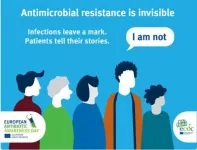(Press-News.org) Washington, DC / Bangalore, India — A new study highlights recent, but fluctuating, growth in global human antibiotic consumption, one of the main drivers of growing antimicrobial resistance (AMR). AMR results in infections that no longer respond to antibiotics (and other antimicrobial medicines) and often leads to longer hospital stays, higher treatment costs, and higher mortality rates. AMR is estimated to be associated with nearly five million global deaths annually.
Researchers affiliated with the One Health Trust (OHT), the Population Council, GlaxoSmithKline, the University of Zurich, the University of Brussels, Johns Hopkins University, and the Harvard T.H. Chan School of Public Health analyzed pharmaceutical sales data from 67 countries from 2016-2023 for the effects of the COVID-19 pandemic and economic growth on human antibiotic consumption. The study provides a breakdown of global antibiotic sales in reported countries by national income level, antibiotic class, and antibiotic grouping according to the World Health Organization’s (WHO) AWaRe classification system for antibiotic stewardship and projects consumption through 2030. The study is published in the Proceedings of the National Academy of Sciences (PNAS).
The study found:
Overall antibiotic sales increased in reporting countries from 2016-2023. Antibiotic sales in 67 reporting countries increased by 16.3 percent from 2016 to 2023, from 29.5 billion defined daily doses (DDDs) to 34.3 billion DDDs. This result reflected a 10.2 percent increase in the overall consumption rate in these countries from 13.7 to 15.2 DDDs per 1,000 inhabitants per day.
Before the COVID-19 pandemic, antibiotic consumption rates in high-income countries were decreasing, and consumption rates in middle-income countries were increasing. From 2016-2019, antibiotic consumption rates (DDDs per 1,000 inhabitants per day) increased in middle-income countries (9.8 percent) while decreasing in high-income countries (-5.8 percent).
The COVID-19 pandemic was significantly correlated with an overall reduction in antibiotic sales, most pronounced in high-income countries. An interrupted time series analysis showed that the onset of the COVID-19 pandemic in 2020 resulted in significantly decreased antibiotic consumption rates across income groups. The decrease was most pronounced in high-income countries, with the consumption rate falling 17.8 percent from 2019 to 2020. In 2021, lower-middle-income countries led high-income countries in antibiotic consumption rates as high-income countries experienced more sustained reductions.
Middle-income countries experienced increased Watch antibiotic sales relative to Access antibiotic sales throughout the study period. High-income countries consumed consistently higher and overall increasing levels of Access antibiotics compared to Watch antibiotics as defined by the WHO’s AWaRe system. Middle-income countries consumed consistently higher and overall increasing Watch antibiotics relative to Access antibiotics.
Middle-income countries experienced the largest increases in antibiotic consumption rates from 2016-2023. All five of the regions with the largest increases in their antibiotic consumption rate over the study period were made up of middle-income countries.
By 2030, global consumption is expected to increase by 52.3 percent to 75.1 billion DDDs. Global projections based on the data from 67 countries show that by 2030, antibiotic consumption is expected to increase from 49.3 billion DDDs by 52.3 percent (uncertainty range [UR]: 22.1 to 82.6 percent) to a total of 75.1 (UR: 60.2 to 90.1) billion DDDs.
This study sheds light on recent trends in consumption across country income levels that can be used to help promote the careful use of antibiotics and other public health interventions that may reduce antibiotic consumption, such as improved infection prevention and control measures and increased childhood vaccination coverage. The study also has implications for future pandemic preparedness.
According to Dr. Eili Klein, lead author of the study and Senior Fellow at OHT, “The COVID-19 pandemic temporarily disrupted antibiotic use, but global consumption has rebounded quickly and continues to rise at an alarming rate. To address this escalating crisis, we must prioritize reducing inappropriate antibiotic use in high-income nations while making substantial investments in infrastructure in low- and middle-income countries to curb disease transmission effectively.”
“Global trends in antibiotic consumption during 2016–2023 and future projections through 2030” is available in PNAS (DOI: 10.1073/pnas.2411919121).
###
About the One Health Trust
The One Health Trust (OHT), which was founded as the Center for Disease Dynamics, Economics & Policy (CDDEP) in 2010, uses research and stakeholder engagement to improve the health and well-being of our planet and its inhabitants. For more than a decade, OHT researchers have conducted vitally important work on major global health challenges, including Covid-19, antimicrobial resistance, hospital infections, tuberculosis, malaria, pandemic preparedness and response, vaccines, medical oxygen shortages, and noncommunicable diseases. OHT’s mandate includes issues related to climate change, biodiversity protection, and the effect of changing human diets on the planet.
At OHT, we believe that answers to the world’s most critical questions lie between disciplines. Accordingly, our researchers employ a range of expertise—from economics, epidemiology, disease modeling, and risk analysis to clinical and veterinary medicine, geographic information systems, and statistics—to conduct actionable, policy-oriented research.
OHT has offices in Washington, D.C. and Bangalore, India, with researchers based in North America, Africa, and Asia. Our projects lead to policy recommendations and scientific studies published in leading journals. We are experienced in addressing country-specific and regional issues as well as global challenges. Our research is renowned for innovative approaches to design and analysis, and we communicate our work to diverse stakeholders.
END
The research team, led by Durham University’s Department of Anthropology, studied two groups of wild bearded capuchin monkeys in Brazil’s Serra da Capivara National Park.
The researchers installed a large box in the park which contained food that the monkeys could access by either lifting a door or pulling a knob.
The team observed which monkeys learned how to access the food, and how that information then spread to the rest of their group.
The researchers specifically focused on the role played by social tolerance in the learning of the problem-solving behaviour.
Social tolerance determines who is allowed ...
Climate change is making water scarcer. A promising method to combat this problem is desalination technology because it can tap seawater. Though desalination has potential, it also brings risks with environmental impact, cost, and accessibility. Zero liquid discharge (ZLD) technology aims to increase water recovery from desalination by squeezing more water out of desalination brine. ZLD can help reduce water scarcity and waste from desalination plants, but comes at increased costs and, potentially, increased environmental effects from desalination.
In ...
WASHINGTON — Cmdr. J. Aaron Roberts relinquished command of the U.S. Naval Research Laboratory’s (NRL) Scientific Development Squadron (VXS) 1, the Warlocks, to Cmdr. Luis A. Levine, the new Commanding Officer (CO), during a change of command and retirement ceremony Nov. 14 at Naval Air Station (NAS) Patuxent River, Maryland.
NRL’s CO Capt. Jesse Black presented Roberts with the Meritorious Service Medal. Roberts served as the VXS-1 CO from May 2023 to November 2024 and the U.S. Navy for 21 years. Black said Roberts’ distinguished leadership was instrumental to the squadron’s continued record of exceptional support to NRL’s airborne ...
PHILADELPHIA, PA – November 18, 2024 – Opertech Bio, Inc., a leading innovator in taste assessment, today announced the publication of a research article in which the TāStation® rapid throughput taste evaluation system was used to resolve a central question about sweet taste perception.
It has been well established that sweeteners impart their taste by activating the TAS1R2/TAS1R3 “sweet taste receptor” in the tongue. A second signaling pathway involving the activity of glucose transporters, operating independently of the receptor, recently has been proposed for metabolizable caloric sweeteners. In a powerful demonstration of the analytical ...
Southwest Research Institute has won a $60 million contract to build three coronagraphs for the National Oceanic and Atmospheric Administration (NOAA). SwRI’s novel Space Weather Solar Coronagraph (SwSCOR) is NOAA’s next-generation instrument to provide early detection and characterization of Earth-directed coronal mass ejections (CMEs).
CMEs are huge bursts of coronal plasma threaded with intense magnetic fields ejected from the Sun over the course of several hours. CMEs arriving at Earth can generate geomagnetic storms, which can cause anomalies in and disruptions ...
Between 2019 and 2023, antibiotic consumption in the EU increased by 1%, moving further away from the 2030 target of a 20% reduction recommended by the Council of the European Union.
Although there have been significant reductions in methicillin-resistant Staphylococcus aureus bloodstream infections during the same period, the situation in other critical areas, such as carbapenem-resistant Klebsiella pneumoniae bloodstream infections, has worsened, with an increase in incidence by almost 60% between 2019 and 2023. This represents a growing threat to patients in hospitals across the EU, particularly since very few therapeutic options remain available to treat patients infected with ...
So maybe the naysayers and detractors of online gaming and its ill effects on youth need to stand down. That’s what science is telling us in a new report in the journal Human Resource Development International from Melika Shirmohammadi, assistant professor at the UH College of Technology.
The article reports that - contrary to popular belief - massive multiplayer online gamers learn by gaming and their skills in the workplace are enriched by those seemingly endless hours previously thought of as frittering away time.
"Online gaming often ...
About The Study: In this study of discharge prescription of a sodium-glucose cotransporter-2 inhibitor (SGLT2i) among patients hospitalized for heart failure, prescription rates increased substantially within 2 years after publication of clinical trial evidence documenting benefit, although considerable variation in rates was found, highlighting the need to understand strategies used by higher prescribing centers to increase SGLT2i adoption.
Corresponding Author: To contact the corresponding author, ...
A new study by researchers at Intermountain Health in Salt Lake City finds that 40 percent of newly diagnosed heart failure patients also have atrial fibrillation – a combination of cardiac disorders that researchers found results in significantly poorer outcomes for patients.
Findings from the Intermountain Health study demonstrate the need for physicians to screen newly diagnosed heart failure patients for atrial fibrillation to ensure patients are getting the best care possible, researchers said.
“Atrial fibrillation can make heart failure much more problematic, and more complex to treat,” said Heidi T. May, PhD, principal investigator of the study and cardiovascular ...
Parag Chitnis, Associate Professor, Bioengineering, College of Engineering and Computing (CEC), received funding for the project: “MTEC-23-06-USAMRDC-MultiTopic-105; Tendon and Joint Injury Prevention and Reduction using Wearable Ultrasound Systems.”
He leads a multi-disciplinary team that aims to produce a new class of wearable hands-free ultrasound systems. Specifically, this system builds on patented technology to provide structural and functional measures for assessing muscle-tendon interactions for preventing tendon overuse injury and assessing joint function, injury, and recovery.
Chitnis received $1,856,023 from Advanced Technology ...






